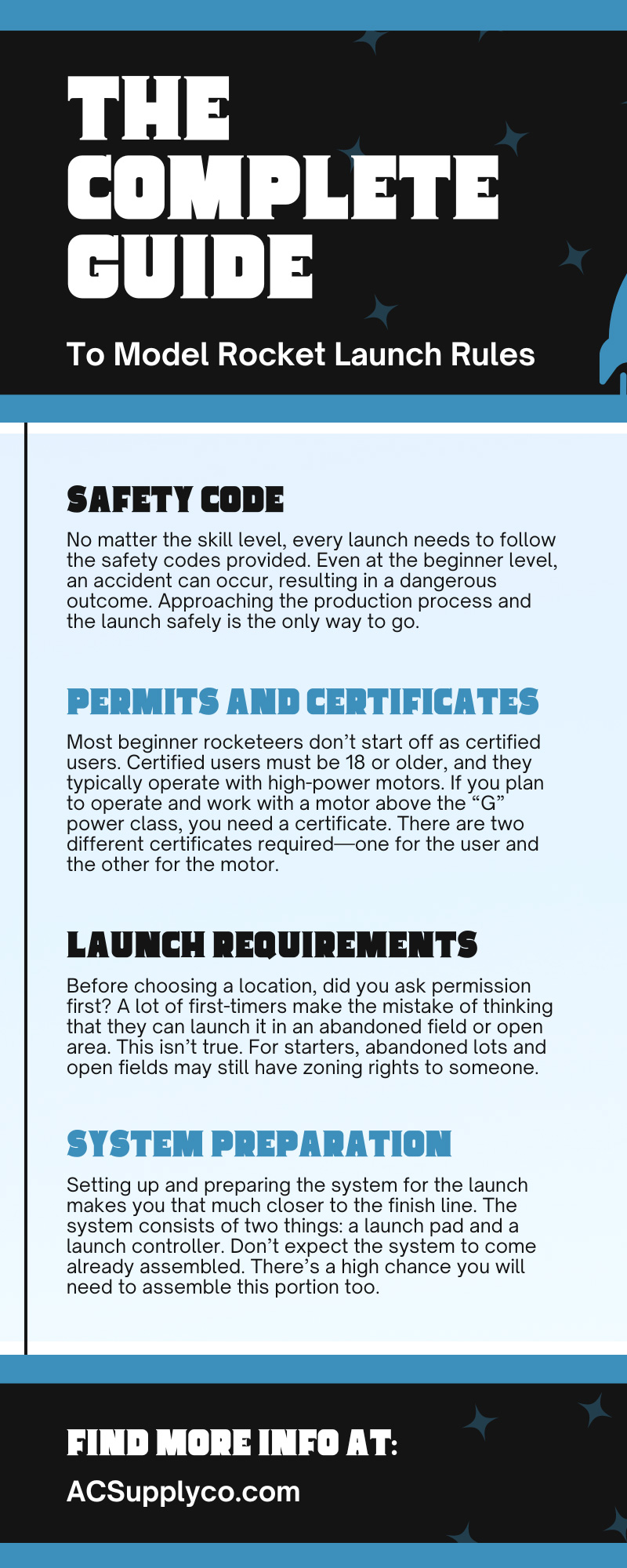Being a model hobbyist is a lot of fun. You’ve found something that intrigues you and comes with a wide variety of selections and options. There will never be a dull moment. And if you’ve decided to become a rocketeer, you’ve signed up for a lot of excitement.
There’s nothing more exhilarating than watching your rocket launch after weeks of building it. But if you’re new to the hobby, there are a few things you need to learn first—like the complete guide to model rocket launch rules.
Safety Code
No matter the skill level, every launch needs to follow the safety codes provided. Even at the beginner level, an accident can occur, resulting in a dangerous outcome. Approaching the production process and the launch safely is the only way to go.
The National Association of Rocketry (NAR) has a specific set of model rocket safety codes they require all rocketeers to follow:
- Rocketeers need to use only lightweight materials and non-metal parts for the nose, body, and fin.
- Rocketeers can use only certified, commercially made model rocket motors. Furthermore, they can’t use them for reasons beyond model rockets or tamper with the design.
- Rocketeers need to launch their rocket with an electrical launch system and electrical motor igniters. Make sure the launch system has a safety interlock.
- If a rocketeer experiences a misfire, they need to remove the safety interlock or disconnect the battery after 60 seconds.
- Rocketeers need to count down before proceeding with the launch and stand 15 feet away for smaller rockets and 30 feet away for larger ones. They also need to ensure that everyone at the site pays close attention.
- Rocketeers must launch their rockets using a launch rod, tower, or rail pointed within 30 degrees of the vertical.
- The model rocket can’t weigh more than 1,5000 grams (53 ounces) and can’t contain more than 125 grams of propellant.
- Rocketeers should never launch their rockets at targets, into clouds, or near airplanes. And they should never attach anything flammable or explosive to the rocket.
- All rocket launches must take place outdoors, in a large open area, and under safe weather conditions with wind speeds no greater than 20 miles per hour.
- Rocketeers need to recover their rockets using streamers or parachutes.
- Rocketeers should never attempt to recover their rockets from power lines or tall trees.
Adhering to these safety codes is straightforward, and rocketeers need to read through all of them before starting the process or proceeding with a launch.
Permits and Certificates
Most beginner rocketeers don’t start off as certified users. Certified users must be 18 or older, and they typically operate with high-power motors. If you plan to operate and work with a motor above the “G” power class, you need a certificate. There are two different certificates required—one for the user and the other for the motor.
Certified motors need to pass several static testing programs specified in the NFPA codes. Hobby rocket motors no longer need to obtain a Federal explosives permit to sell, purchase, store, or fly a rocket. For the more advanced rockets, there are a few more specifications you might need to look into. But these only apply to experienced and highly skilled rocketeers.
Launch Requirements
Before choosing a location, did you ask permission first? A lot of first-timers make the mistake of thinking that they can launch it in an abandoned field or open area. This isn’t true.
For starters, abandoned lots and open fields may still have zoning rights to someone. Launching a rocket on their property without permission could result in them taking legal action, especially if it damages the property.
Choose a spot and do thorough research on the location. Find the contact information for the owner and explain to them why you want to use their property. As you search for a site location, make sure you find an area with few trees and power lines in the way.
Rocket Classifications
For every rocket design, there is a classification assigned to it. Learning which category yours falls under and staying within that bracket will help ensure a successful and safe launch. This way, you know the limitations and parameters you need to adhere to.
Class 1 Model Rocket
These rockets use slow-burning propellants of no more than 125 grams. The parts are paper, plastic, or wood, and they don’t contain substantial metal parts. This model should weigh no more than 53 ounces with the propellant included.
Class 2 High Power Rocket
A class two model rocket has two distinctions from a class one. The motors have a combined impulse, and the calculations may vary and fluctuate. You could see 40,960 Newton seconds or less. And this model requires a Certificate of Waiver or Authorization (COA) before flying in a controlled location.
Class 3 Advanced High Power Rocket
Class three requires FAA approval and Air Traffic Control facility notification. These models also require a COA before attempting a launch. Their sophistication and complicated build make them slightly more dangerous.
System Preparation
Setting up and preparing the system for the launch makes you that much closer to the finish line. The system consists of two things: a launch pad and a launch controller. Don’t expect the system to come already assembled. There’s a high chance you will need to assemble this portion too.
Carve out enough time on the day of the launch to ensure calculations are correct and the rocket is secure. Set up a three- to four-leg platform on stable ground. You should choose an area where the grass is a little moist so that it’s not difficult to secure the legs into position.
The launch controller will be an electrical piece of equipment that ignites the rocket igniter with the appropriate voltage. Check out one of our model rocket launch sets here at AC Supply to make the process easier for you.
Launch Preparation
Once you’ve got everything set up, follow these final steps:
- Conduct a safety check for yourself and everyone in the area
- Secure the rocket to the launch rod
- Connect the igniter to the launch controller
- Get ready for blast off
We love everything about model rockets, and that’s why we want to supply you with this complete guide to model rocket launch rules! For more information, visit our website.



